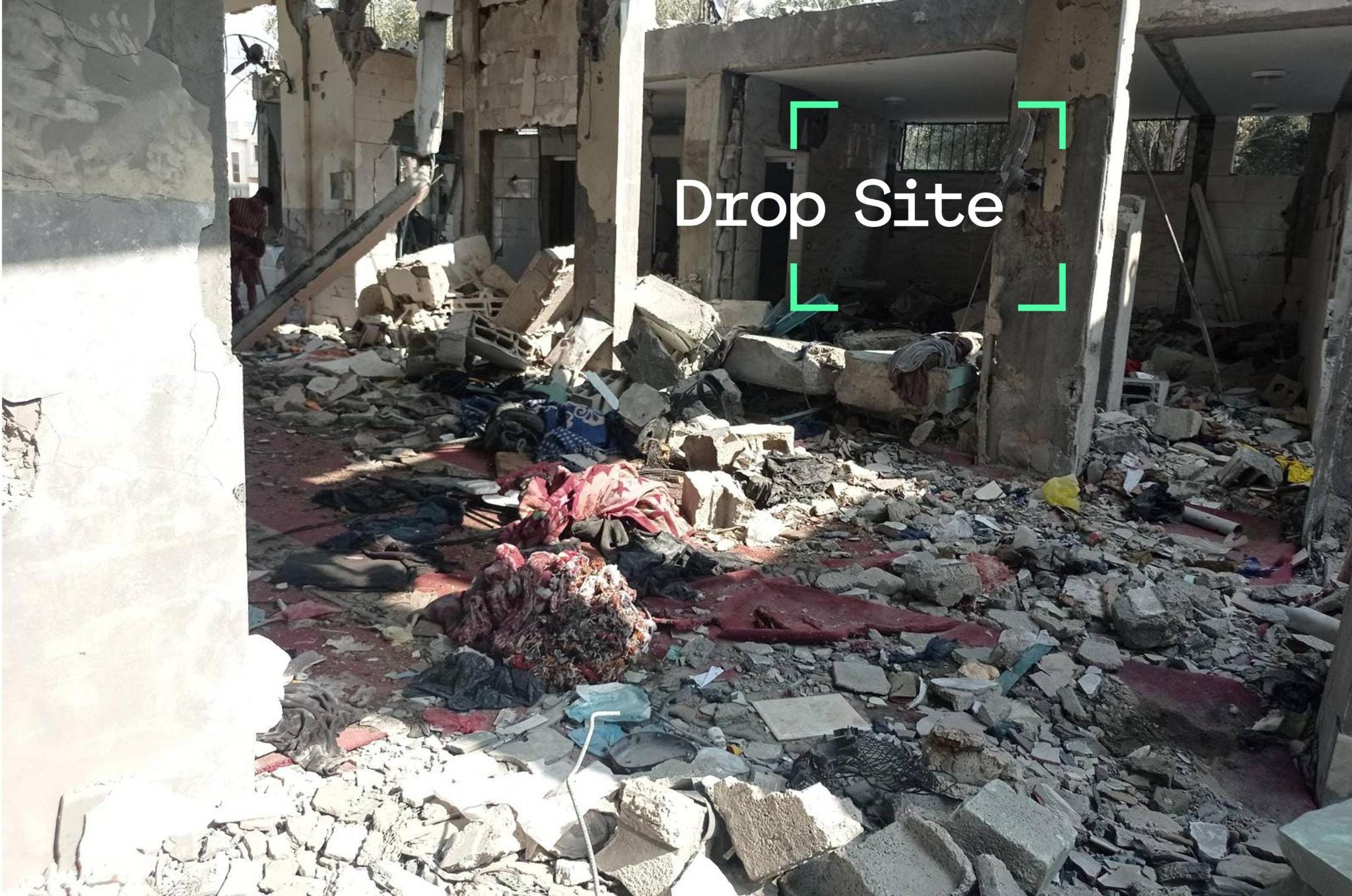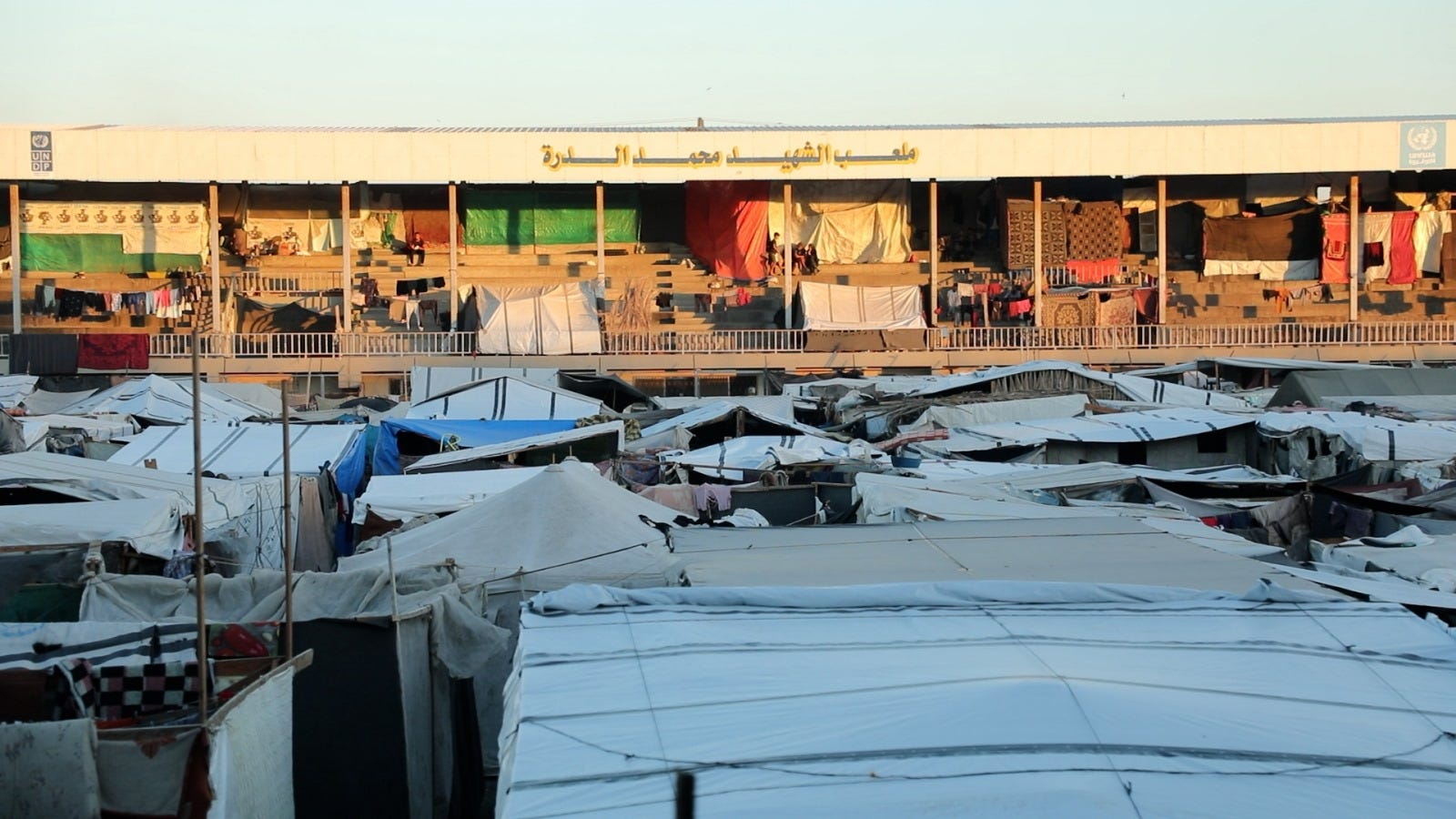
Story by Abubaker Abed
DEIR AL-BALAH — Early Sunday, well before dawn, I couldn’t sleep—like so many days before it, the sound of the drones had kept me up—and I heard the massive explosion at the al-Aqsa Martyrs Mosque, which shook the entire area. A few hours later, I went to the scene. I wish I hadn’t. What I saw made me lose my mind: pieces of flesh scattered all over the rugs, blood splashed over people's belongings, food and medicines crushed and burnt. The smell of blood is still haunting me. I have no words left while being subjected to this holocaust. I’ve prayed at that mosque and met many people there. Now, they’ve simply vanished.
This is life in Deir al-Balah. And yet, Deir al-Balah may be Gaza’s last remaining hope.
Moataz Abu-Qass, too, was violently awakened on Sunday morning by an Israeli missile strike at 2:30 a.m. on the al-Aqsa Martyrs Mosque. Moataz is 14. Forcibly displaced from his home in the neighborhood of al-Shujaeya in Gaza City, he and his family had taken shelter in a tent near the mosque in Deir al-Balah.
"We were sleeping, and suddenly the entire area was on fire. Clouds of smoke covered the sky and I couldn’t see anything at all. I rushed to the mosque and saw people dismembered, the ripped skin of children, blood spattered over cans of food and people's belongings. I am honestly shaking from what I've just seen,” he told me.
At least 26 people were killed and dozens injured in twin attacks on the mosque and the Ibn Rushd school, where thousands of the displaced had sought shelter. "Everyone was screaming in panic and pain. It was so dark, and we couldn't see to collect the remaining body parts of people who were earlier transferred to the hospital. The blood of these people hasn't even dried yet,” said Moataz. “This is our life. We came south, but it seems worse than the north. I implore you and everyone to stop the war. Please stop it.”
Over the past two weeks in Deir al Balah, every day has been an episode of sheer horror. Drones constantly buzz overhead, Apache helicopters bomb tents and compounds, and F-16 warplanes level buildings.
Over the past year, in Gaza, homes, refugee camps, hospitals, schools, universities, bakeries, roads, stadiums, and archaeological sites have all been targeted and destroyed. Gaza has lost almost all of its historic landmarks, including the Great Omari Mosque, the Islamic University of Gaza, Al-Yarmouk stadium, to name just a few. Nearly 42,000 people have been killed in Gaza over the past year and more than 97,000 have been wounded, according to the Gaza Health Ministry. Those are conservative estimates. Ninety percent of Palestinians in Gaza, over 1.9 million people, have been displaced from their homes, according to the United Nations. Israel has destroyed or damaged over 156,000 buildings in Gaza, including more than 70,000 housing units.
A UN map of Gaza published last week with areas subject to Israeli military operations or displacement orders shaded in red shows only a tiny sliver of territory close to the coast that remains in white — much of it in the city of Deir al-Balah.
Deir al-Balah is the only city in Gaza that Israeli forces haven’t fully invaded by Israeli troops. Its eastern parts have been heavily attacked and demolished but overall, it hasn’t lived through the utter devastation that other cities, like Gaza City, Khan Younis, Rafah, and Beit Lahiya, have.
This palm-lined city is now home to Gaza’s sole standing university, archaeology site, and stadium. Its agriculture is also still in bloom, with palm and olive trees adorning every street – streets that have been turned into encampments.
The Deir al-Balah municipality has been finding it difficult to provide a minimal standard of living for the people who have recently fled there, especially in the wake of Israel’s invasion of Rafah in May. Almost a million Palestinians have come to Deir al-Balah since then, desperately trying to find safety where none really exists.
Fakher Al-Kurd, an engineer at the Deir al-Balah municipality, prays for the city to remain somewhat intact. “Here are the last landmarks of Gaza: Al-Khadr Shrine, Al-Dorra Stadium, and Palestine Technical College,” he told me. “Gaza will be reborn if Deir al-Balah remains intact, which is something we here at the municipality call on the entire world to act for and stop the Israeli military from turning the city into a pile of rubble.”
“These sites are symbols of our existence, our culture, and our identity. At all costs, we’re determined to intensify our efforts to welcome the doors of the city to everyone now and after the war. Our ultimate hope is an end to this war.”
Al-Khadr Shrine or the monastery of Christian monk Hilarion, built in the mid-4th century AD, plays a major role in the history of the city. It is one of two reasons why the city was named Deir al-Balah. Deir refers to the shrine. Al-Balah refers to the date palms.
The shrine was renovated in 2016 and became a library for Palestinians across the territory. Before the genocide, visitors from all around Gaza would visit it daily. Amena Samra, a projects officer at the Nawa association, which oversees the site, stresses the importance of Al-Khadr Shrine in Deir al-Balah, since it is both a small mosque and a church nestled next to each other. “The shrine is the identity of Gaza and its ancient civilization. It also connects the roots of the community and consolidates the Palestinian identity through the various activities the association provides,” she said. “We were always keen on taking memorial photos of the shrine. We hope this war will end, and this historic landmark will remain because it’s the last thing that defines the history of Gaza.”
At the heart of Deir al-Balah is Palestine Technical College. The university, first established in 1992 and then renovated in 2006, was once a vibrant and thriving learning institution. It has stopped functioning but with the total destruction of all of Gaza’s other universities, Palestine Technical College is the only physical one left standing across the enclave.
Abeer Al-Manama, a student affairs employee at Palestine Technical College, is devastated by the forced transformation of the college from what was once her university and workplace into a refuge for the displaced.
"It feels like I’ve lost my home, my memories, and everything. It still pains me how it looks now. The existence of such an educational institution after the destruction of every university in Gaza will usher in building our generations that will make Gaza flourish again,” she said. “Saving educational facilities must be through unified and intensified efforts by international organizations, governments, and the international community. Palestine Technical College will formulate the restart of education in Gaza, especially face-to-face learning, which will secure a conducive and safe environment for all."

Meanwhile, out of Gaza's ten stadiums, only one remains: Al-Dorra Stadium in Deir al-Balah. Funded by Saudi Arabia, the stadium was redeveloped and reopened in 2018 during the opener of the second Gaza Premier League match week.
According to the Palestinian Football Association, over 454 athletes have been killed by Israel in Gaza, including 313 footballers, 87 of whom were children. In total, more than 50 sports facilities have been obliterated.
“The stadium is our hope to rebuild sports in Gaza after the war. It’s also a source of inspiration and resilience in the face of the current extreme adversity. For us, it is more than just a stadium. It’s a part of our sports identity,” Deema Yousef, spokesperson of the PFA, said. “We want to emphasize that sports are a part of our identity, too. We love and breathe football. FIFA and the IOC's statutes, and even international law, underline the protection of sports facilities at times of conflict. But since Israel is unpunishable, it can exceed all these red lines.”
"There's a reason why Deir al-Balah is Gaza’s womb,” Al-Kurd, the engineer, told me. Long known as the capital of central Gaza, Deir al-Balah is now the mother that will give birth to a new Gaza. As a lifelong resident from Deir al-Balah, I can only dream that this city will remain standing, and, once this genocide is finally over, it will be a place from which we can all begin to rebuild.
Abubaker Abed is a 21-year-old journalist who was thrown into conflict reporting as the bombs rained down on Gaza. Abed was born and raised in Deir al-Balah, which has been heavily bombed but remains the only city in Gaza that has not been fully invaded by Israeli troops and razed to the ground.





And let it be noted that Iran has not attacked a single Israeli Temple, school, hospital or apartment building.
Dear Abubaker Abed…I have seen you many times on the Electronic Intafada live stream. You are such a kind, strong, positive person. Do not lose hope. You are the one that gives me hope! Every time you speak to us I feel calmer and more assured. I hold you and every Palestinian in my heart.